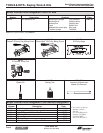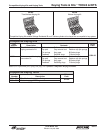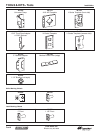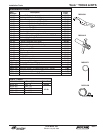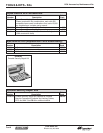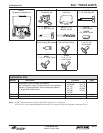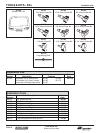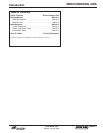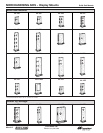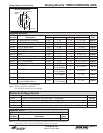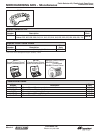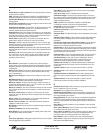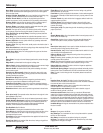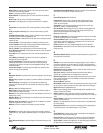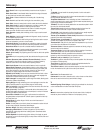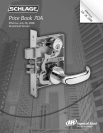
Glossary
Price Book 70A
Effective July 28, 2008
Gloss-2
Door Stop:
A device to stop the swing or movement of a door at a certain
point. Also an architectural term defining that part of a door frame against
which the door closes.
Double Cylinder Dead Bolt:
Any type of auxiliary lock requiring a key
to project or retract the dead bolt (lock or unlock) from either side.
Double-Throw Bolt:
A bolt that can be projected beyond its first
position into a second, or fully extended one, thus providing extra security.
Drawer Roller:
A device used to ease the sliding of a drawer open or
shut, usually with a metal or fiber wheel rotating in a metal frame.
Drawer Slides:
A mechanism employing guides and rollers that guide
and support the drawer, permitting easy operation.
Drivers:
The upper set of pins in a pin tumbler cylinder, which, activated
by the springs, project into the plug until raised by insertion of the key.
Drop Escutcheon (or Key Plate):
One having a pivoted plate that
covers the key hole.
Drop Ring:
A ring handle attached to a spindle that operates a lock or
latch. The ring is pivoted but remains in a dropped position when not in use.
Dummy Cylinder:
A mock cylinder without any operating mechanism
for use where effect is desired.
Dummy Trim:
Trim only, without lock; usually used on the inactive door in
a pair of doors.
Dust-Proof Strike:
A strike with a spring plunger that completely fills the
bolt hole when the bolt is not projected.
Dutch Door Bolt:
Device for locking together the upper and the lower
leaves of a Dutch door.
E
Edge Plate
: An angle or channel-shaped guard used to protect the edge
of a door.
Edge Pull:
A pull mortised into the edge of a sliding door.
Elbow Catch:
A spring-loaded device embodying a rocker arm and angle
strike, for locking the inactive leaf of a pair of cabinet locks.
Electric Strike:
An electrical device that permits releasing of the door
from a remote control.
Escutcheon (Elongated):
A plate long enough to span a lock case
and having holes for knob bushing, bit key, cylinder, turn knob and similar
operating members as required.
Escutcheon (Key):
See Key Plate.
Exit Device:
A door-locking device de signed to grant instant exit by
pressing on a cross bar that releases the locking bolt or latch.
Extension Flush Bolt:
A flush bolt in which the connection between
bolt head and operating mechanism is by means of a rod inserted through a
hole bored in the thickness of the door.
Extension Link:
A device used to provide long backsets in bored locks.
F
Face (of a lock):
The exposed surface that shows in the edge of a door
after installation. (See Front.)
Fast Pin Hinge:
One in which the pin is fastened permanently in place.
Finish Builders Hardware:
Hardware that has a finished appearance
as well as a functional purpose and that may be considered a part of the
decorative treatment of a room or building. Also termed Architectural
Hardware, Finish Hardware and Builders Finish Hardware.
Fire Exit Bolt:
See Exit Device.
Floor Closer:
A closing device installed in the floor under a door.
Floor Hinge:
A combined pivot hinge and closing device set either in the
floor or in the bottom of the door. It may be spring type only or may be
combined with liquid control.
Flush Bolt:
A door bolt so designed that when applied it is flush with the
face or edge of the door.
Flush Cup Pull:
A pull mortised flush into a door, having a ring pull that
folds Hat into the cup of the pull.
Flush Ring:
A flush door pull mortised in a door, having a ring pull that
folds flat into the cup of the pull.
Foot Bolt:
A type of bolt applied at the bottom of a door and arranged for
foot operation. Generally the bolt head is held up by a spring when the door
is unbolted.
Friction Catch:
Any catch which when it engages a strike is held in the
engaged position by friction.
Friction Hinge:
A hinge designed to hang a door and hold it at any
desired degree of opening by means of friction control incorporated in the
knuckle of the hinge.
Front (of a lock):
The plate through which the latching or locking bolts
project. (See Face.)
G
Grand Master Key:
A key that operates locks in several groups, each of
which has its own master key.
Guard Bar:
A series of two or more cross bars generally fastened to a
common back plate to insure protection of glass or screen in a door.
H
Hand (of a lock, etc.):
A term used to indicate the direction of swing or
movement, and/or locking security side of a door.
Handed (locks, etc.):
A term used to indicate that the article is for use
only on doors of the designated hand.
Harmon Hinge:
A hinge designed to swing a door into a pocket at a
right angle with the frame.
Hasp:
A fastening device consisting of a loop and a slotted hinge plate,
normally secured with a padlock.
Hinge:
Two plates pined together by a pin and attached to a door and its
frame whereby a door is supported and is enabled to swing or move.
Hinge Stile (of a door):
The stile to which the hinges are applied as
distinguished from the lock stile.
Horizontal Spring Hinge:
A spring hinge mortised horizontally into the
bottom rail of a door and fastened to the floor and head frame with pivots.
Hub:
The part of a lock through which the spindle passes to actuate the
mechanism.
I
Inactive Door (or leaf):
That leaf of a pair of doors that does not
contain a lock, but is bolted when closed, and to which the strike is fastened
to receive the latch or bolt of the active door.
Indicator Button:
A device used in connection with a hotel lock to
indicate whether or not the room is occupied.
Integral (locks and latches):
A term used to describe a type of
mortise lock having cylinder in the knob.
Interconnected Lock:
(Also known by a number of different trade
names) A lock having a separate latch and dead bolt mechanically intercon-
nected and installed in round bored openings in the face and edge of a door.
It is best known for providing dead bolt security with the life safety feature of
simultaneous retraction. When the dead bolt is projected, a single turn of the
inside knob retracts both the dead bolt and the latch bolt. This simultaneous
retraction function is also available with some functions of mortise locks.
Invisible Hinge:
A hinge so constructed that no parts are exposed when
the door is closed.
K
Keeper:
Synonymous with Strike.
Key Change:
The combination of cuts in a key that enable it to operate
the lock for which intended.
Key Plate:
A small plate or escutcheon having only a keyhold.
Keyway:
The aperture in lock cylinders that receives the key and closely
engages with it throughout its length.



